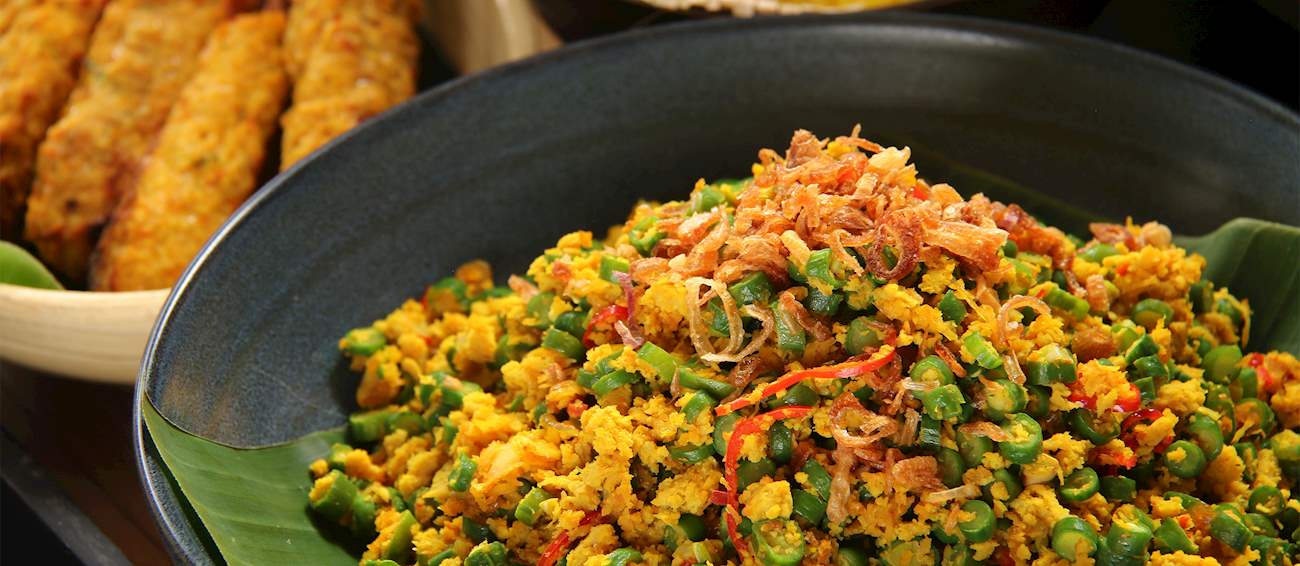MAIN INGREDIENTS
Traditionally made by the native Minahasan people and hailing from North Sulawesi, this Indonesian dish employs fruit bat as the main ingredient. Though bats are often fried or grilled, the most popular way is to incorporate them into paniki, the traditional soup-like dish.
The usual procedure starts with grilling the bat to remove all the hairs covering its body. The bat is then cleaned, its intestines are removed, and it is cut into smaller chunks and boiled in water. The dish is finished off with the addition of fried onions, garlic, ginger and chili paste, leeks, curry leaves, lemongrass, and coconut milk.
Lawar is a versatile Balinese dish usually consisting of chopped meat and vegetables that are typically mixed with coconut, chili powder, shrimp paste, kaffir lime leaves, galangal, and turmeric. Traditional lawar is made with pork or turtle, but chicken, duck, or beef can also be used.
Pig blood is added for color and flavor in most variations of this dish. Lawar is usually prepared for ceremonies and other special occasions, so it is often made in large quantities. However, it can also be found at any restaurant or warung in Bali.
MOST ICONIC Lawar
View moreMAIN INGREDIENTS
Bakso ayam is a traditional dish and a type of bakso (meatball) originating from Indonesia. These meatballs are usually made with a combination of chicken, garlic, oil, salt, sugar, corn starch, and baking powder. The ingredients are shaped into chicken meatballs that are boiled in water.
Once taken out of the pot, the meatballs are plunged into ice-cold water. They can be eaten as they are or incorporated into a delicious chicken meatball soup called sup bakso ayam. It's recommended to use lean chicken breast when preparing bakso ayam.
Nasi tim is a traditional rice dish. The dish is usually prepared with chicken, and it's then called nasi tim ayam, while the addition of shiitake mushrooms makes it called nasi tim ayam jamur. The chicken is usually seasoned with soy sauce and garlic and it's placed at the bottom of a tin bowl, along with some chicken stock.
The meat is topped with rice, and the combination is steamed until done. Sometimes, a hard-boiled egg will be placed at the bottom of the bowl with the chicken. This dish is always served hot, which is the reason why it's regarded as comfort food.
Due to the soft texture and slightly bland flavors, nasi tim ayam is suitable for small children.
MAIN INGREDIENTS
Semur ayam is a traditional dish originating from Java. The dish is usually made with a combination of chicken, potatoes, sweet soy sauce (kecap manis), nutmeg, lemongrass, garlic, shallots, ginger, sugar, salt, and pepper. The shallots, garlic, ginger, and lemongrass are sautéed in oil, and the chicken pieces are then added to the pan, followed by the rest of the ingredients.
The mixture is brought to a boil and simmered until both the potatoes and the chicken become tender. Semur ayam is served hot with steamed rice on the side. If desired, the stew can be garnished with fried shallots.
MAIN INGREDIENTS
Bakso bakar is a traditional street food item and a type of bakso or Indonesian meatballs. The meatballs are usually made with a combination of beef, starch, eggs, soy sauce, and diluted margarine. The meat mixture is often flavored with garlic, nutmeg, salt, and pepper.
Once shaped, the meatballs are shortly boiled or steamed, skewered, then grilled over charcoal until fully cooked. Bakso bakar can be bought from street food vendors, but it can also easily be made in the comfort of your own home. This type of bakso should look similar to its Japanese cousin, yakitori.
MAIN INGREDIENTS
Selat solo is an Indonesian dish believed to have originated as a European salad that’s been adapted to Javanese tastes. It hails from Solo in Central Java, hence the name. The dish is made with a combination of beef tenderloin, onions, soy sauce, salt, pepper, sugar, vinegar, shallots, cloves, nutmeg, hard-boiled eggs, mayonnaise, and vegetables such as carrots, lettuce, potatoes, and green beans.
The vegetables and eggs are layered in plate, the meat is then placed over them, and the watery soup is poured over the meat. The dish is traditionally served with a bit of mayonnaise on the side and can be categorized as a main meat dish, a salad, and a soup.
MAIN INGREDIENTS
This Indonesian goat stew originated in Surakarta, Java. It is believed that the dish appeared during the Dutch rule when the best goat cuts were usually distributed among the rich, and what was left for the poor were goat bones which still had some meat attached to them.
The bones are cooked in a thin, coconut-milk-based broth that is enriched with various herbs and spices such as turmeric, galangal, lemongrass, cumin, coriander, garlic, and onions, while some establishments also may include the addition of goat innards.
MOST ICONIC Tengkleng
View moreMAIN INGREDIENTS
Semur daging is a traditional stew originating from Java. It is usually made with a combination of beef, onions, garlic, ginger, kecap manis, palm sugar, tamarind, cloves, nutmeg, cinnamon, cardamom, oil, salt, and pepper. The onions, garlic, and ginger are seasoned with salt and fried in oil.
The meat is cut into cubes and added to the pan with spices, kecap manis, sugar, and water. The stew is simmered over low heat until the meat becomes tender and the sauce is reduced. It is recommended to serve semur daging with rice and vegetables on the side.
Babi panggang is an Indonesian term which refers to a wide variety of grilled or roasted pork dishes. It is believed that the tradition of preparing pork in Indonesia grew out of Chinese culinary heritage, and because of religious reasons pork dishes are usually found in areas with a predominant Christian and Hindu population.
Besides the extremely popular babi guling, the Balinese suckling pig, there is a broad category of different grilled pork dishes traditional to the area of North Sumatra. Before grilling, the meat is usually marinated in a mixture of traditional Indonesian spices, such as ginger, garlic, galangal, and Indonesian soy sauce ketjap manis.
TasteAtlas food rankings are based on the ratings of the TasteAtlas audience, with a series of mechanisms that recognize real users and that ignore bot, nationalist or local patriotic ratings, and give additional value to the ratings of users that the system recognizes as knowledgeable. For the “13 Worst Rated Indonesian Meat Dishes” list until January 30, 2025, 1,875 ratings were recorded, of which 1,273 were recognized by the system as legitimate. TasteAtlas Rankings should not be seen as the final global conclusion about food. Their purpose is to promote excellent local foods, instill pride in traditional dishes, and arouse curiosity about dishes you haven’t tried.













